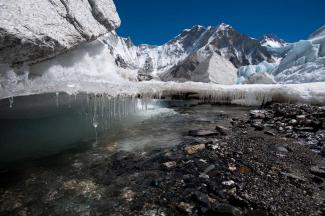The Hindu Kush Himalaya region
Nature is changing rapidly in the Hindu Kush Himalaya
 ICIMOD Kathmandu
ICIMOD Kathmandu
The Hindu Kush Himalaya (HKH) region is also known as the “Third Pole” because it contains the largest volume of ice outside the polar regions. It covers more than 4.2 million square kilometres and is home to all of the world’s peaks above 7000 metres. It spans 3,500 kilometres across Afghanistan, Bangladesh, Bhutan, China, India, Myanmar, Nepal and Pakistan.
Glaciers and snow from the HKH feed into 12 river basins, including 10 major transboundary rivers. They flow through 16 countries in Asia and provide freshwater services to about 240 million people in the HKH region and about 1.65 billion people downstream.
The cryosphere is the frozen part of the Earth. It contains snow, glaciers, permafrost and glacial lakes. Up to 60 % of the HKH region features seasonal cryosphere, and it is transforming in various ways, according to a report by the International Centre for Integrated Mountain Development (ICIMOD). ICIMOD is an intergovernmental organisation headquartered in Kathmandu, Nepal, with presence across the HKH member countries as listed above.
1. Glaciers are rapidly melting. Comparing the period from 2000 to 2009 with the period from 2010 to 2019, their mass loss has increased by 65 %. Global warming between 1.5 and 2 degrees Celsius will cause glaciers in the HKH to lose 30 to 50 % of their volume by 2100. As glaciers recede, glacial lakes expand. The possibility of Glacial Lake Outburst Floods (GLOFs) is expected to increase three-fold by the end of this century. GLOFs can also be transboundary events, meaning that their impacts can be felt across country borders.
2. Permafrost is thawing. Permafrost is frozen soil, rocks and sand held together by ice. Scientists estimate that about 8,340 square kilometres of permafrost area was lost in the western Himalaya between the period from 2002 to 2004 and the period from 2018 to 2020. About 965 square kilometres was lost in the Uttarakhand Himalaya (India) between the period from 1970 to 2000 and the period from 2001 to 2017.
3. Downstream water availability is becoming more uncertain. Glacial melting, permafrost thaw and more erratic snowfall are making water resources less predictable in the region. Some river basins have experienced a decrease in run-off, whereas others have witnessed an increase.
4. Extreme weather is becoming more common. A combination of slow-onset events, like sedimentation and erosion, and fast-onset hazards, like floods and GLOFs, can cause extreme-weather events to cascade in ways that are difficult to address.
5. Temperatures are rising. The mean temperature across the HKH is gradually increasing, with an average trend of 0.28 degrees Celsius per decade. Increased warming rates at higher elevations are being witnessed in nine of the 12 river basins.
Even though it can be difficult to attribute specific events to climate change, scientists agree that man-made global warming is the driving force behind the changes in the cryosphere. Policymakers need to assess them in order to analyse the subsequent changes on ecosystems and livelihoods and formulate effective adaptation strategies.
Communities at risk
Approximately 129 million farmers in the Indus, Ganges and Brahmaputra river basins depend on water from glacier melt and snowmelt to irrigate their crops, especially during spring and summer. As glaciers continue to melt, most HKH river basins are expected to reach ‘peak water’ by the middle of the 21st century, which means that there would be an increase in water availability. However, this will be followed by a decrease in overall water availability by the end of this century, posing a significant threat to the livelihoods of a vast number of people dependent on these river basins for agriculture and other purposes.
As a result of changes to the cryosphere, mountain communities are facing crop losses, fodder shortages, livestock deaths, a decrease in the availability of medicinal plants and species migration to higher elevation, among other things. In many areas of the HKH, communities have already abandoned agriculture and pastoralism due to changes in water availability and other factors. This has increased the socioeconomic vulnerability of mountain communities and exacerbated food and nutrition insecurity.
Evaluating climate impacts
The authors of the report recommend evaluating the current and future impacts of climate change. With regard to permafrost, governments of the HKH member countries should focus on monitoring the ground, especially where infrastructure or communities are vulnerable to thawing.
Regarding glaciers, measuring the thickness of ice and debris, ice temperatures and glacier velocity is important. Models of glacier processes should be improved and better interconnected with hydrological models. More information is needed on how glacier change can be attributed to human activities.
Since the contribution of different water sources to river flows is changing, policymakers should prepare for seasonal shifts in water availability. They should develop adaptation strategies to tackle extreme weather events.
Moreover, mountain communities need to be provided significant resources and technological support to adapt to these environmental challenges. It is crucial for climate-change adaptation policies to be inclusive and implemented fairly, considering both social and ecological aspects.
Intensifying cross-border cooperation is necessary to effectively preserve the common heritage of the HKH region as indicated by the HKH Call to Action published by ICIMOD. The authors state that “transboundary cooperation in the HKH is lacking mainly because the focus of intergovernmental initiatives has been on political and economic interests, rather than social and environmental well-being at the regional scale.”
Links
ICIMOD, 2023: Water, ice, society, and ecosystems in the Hindu Kush Himalaya.
https://hkh.icimod.org/hi-wise/hi-wise-report/
ICIMOD, 2020: The HKH Call to Action to sustain mountain environments and improve livelihoods in the Hindu Kush Himalaya.
https://www.icimod.org/hkh-calltoaction/
Syed Muhammad Abubakar is an environmental journalist based in Pakistan.
s.m.abubakar@hotmail.com


